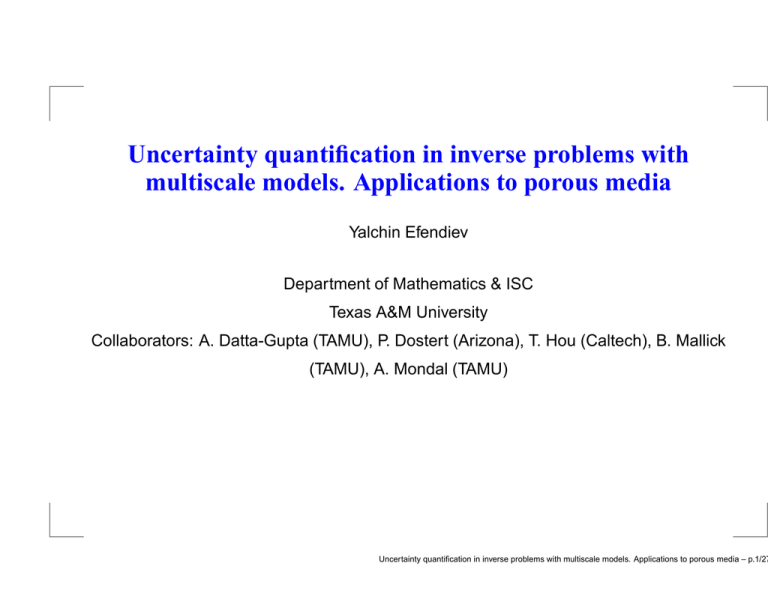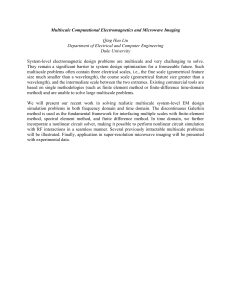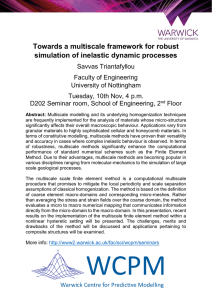Uncertainty quantification in inverse problems with
advertisement

Uncertainty quantification in inverse problems with
multiscale models. Applications to porous media
Yalchin Efendiev
Department of Mathematics & ISC
Texas A&M University
Collaborators: A. Datta-Gupta (TAMU), P. Dostert (Arizona), T. Hou (Caltech), B. Mallick
(TAMU), A. Mondal (TAMU)
Uncertainty quantification in inverse problems with multiscale models. Applications to porous media – p.1/27
Introduction
• We consider a problem of characterizing subsurface properties given
“coarse-scale” measurements.
• Subsurface properties are highly heterogeneous with uncertainties at “small”
scales that can affect the measurement results.
9
3
8
2
7
6
1
5
0
4
3
−1
2
−2
1
0
−3
−1
• The relation between the input (subsurface properties in this talk) and the output
(e.g., oil production rate) is highly nonlinear.
• Inverse problem in a Bayesian framework (uncertainty quantification in inverse
problems, ...): P (k|D) ∝ P (D|k)P (k), where k(x) represents the subsurface
property (permeability, e.g.).
Uncertainty quantification in inverse problems with multiscale models. Applications to porous media – p.2/27
Illustration
Fractional Flows
1
Exact
Sampled
0.8
F
0.6
0.4
0.2
0
0
0.5
1
PVI
1.5
2
Uncertainty quantification in inverse problems with multiscale models. Applications to porous media – p.3/27
Prototypical model
We consider two-phase flow in a heterogeneous porous formation under the assumption
that the displacement is dominated by viscous effects.
∇ · (λ(S)k∇p) = h,
∂S
+ v · ∇f (S) = 0, v = −λ(S)k∇p.
∂t
Measured data:
F (t) =
R
out
R
vf (S)dl
out
vdl
F(t)
Uncertainty quantification in inverse problems with multiscale models. Applications to porous media – p.4/27
Problem setting
• Given the fractional flow information (integrated response) F (t) and some
precision, we would like to sample k from P (k|F ).
• From Bayes theorem
P (k|F ) ∝ P (F |k)P (k).
• Here P (k) is the prior information, P (F |k) is the likelihood and assumed given by
P (F |k) = exp(−
kFk (t)−F obs (t)k2
).
2
σf
2
obs )k
• Priors can be (1) P (k) = exp(− k log(k)−log(k
) (2) covariance matrix is given
σ2
k
(3) with unknown parameters in the covariance matrix (4) ...
Uncertainty quantification in inverse problems with multiscale models. Applications to porous media – p.5/27
Difficulties
•
•
π(k) = P (k|F ) can be multi-modal and high dimensional.
π(k) = P (k|F ) is not given analytically and involves the solution of nonlinear pde
system.
P
k
Uncertainty quantification in inverse problems with multiscale models. Applications to porous media – p.6/27
Sampling
Algorithm (Metropolis-Hastings MCMC)
• Step 1. At kn generate k from q(k|kn ).
• Step 2. Accept k as a sample with probability
„
q(kn |k)π(k)
p(kn , k) = min 1,
q(k|kn )π(kn )
«
,
i.e. kn+1 = k with probability p(kn , k), and kn+1 = kn with probability 1 − p(kn , k).
Here π(k) is the distribution we would like to sample.
• Direct (full) MCMC simulations are usually prohibitively expensive, because each
proposal requires a fine-scale computation.
• We use algorithms where the proposal distribution is modified using coarse-scale
spatial models.
Uncertainty quantification in inverse problems with multiscale models. Applications to porous media – p.7/27
Priors
11111111111111111111111111111111111111111111111
00000000000000000000000000000000000000000000000
00000000000000000000000000000000000000000000000
11111111111111111111111111111111111111111111111
00000000000000000000000000000000000000000000000
11111111111111111111111111111111111111111111111
00000000000000000000000000000000000000000000000
11111111111111111111111111111111111111111111111
00000000000000000000000000000000000000000000000
11111111111111111111111111111111111111111111111
00000000000000000000000000000000000000000000000
11111111111111111111111111111111111111111111111
00000000000000000000000000000000000000000000000
11111111111111111111111111111111111111111111111
00000000000000000000000000000000000000000000000
11111111111111111111111111111111111111111111111
00000000000000000000000000000000000000000000000
11111111111111111111111111111111111111111111111
00000000000000000000000000000000000000000000000
11111111111111111111111111111111111111111111111
00000000000000000000000000000000000000000000000
11111111111111111111111111111111111111111111111
00000000000000000000000000000000000000000000000
11111111111111111111111111111111111111111111111
00000000000000000000000000000000000000000000000
11111111111111111111111111111111111111111111111
00000000000000000000000000000000000000000000000
11111111111111111111111111111111111111111111111
00000000000000000000000000000000000000000000000
11111111111111111111111111111111111111111111111
00000000000000000000000000000000000000000000000
11111111111111111111111111111111111111111111111
00000000000000000000000000000000000000000000000
11111111111111111111111111111111111111111111111
00000000000000000000000000000000000000000000000
11111111111111111111111111111111111111111111111
00000000000000000000000000000000000000000000000
11111111111111111111111111111111111111111111111
00000000000000000000000000000000000000000000000
11111111111111111111111111111111111111111111111
00000000000000000000000000000000000000000000000
11111111111111111111111111111111111111111111111
00000000000000000000000000000000000000000000000
11111111111111111111111111111111111111111111111
00000000000000000000000000000000000000000000000
11111111111111111111111111111111111111111111111
0000
1111
0000
1111
0000
1111
Facies 2
0000 Facies 1
1111
0000
1111
0000
1111
• Interface modeling with level sets (τ
= const)
∂τ
+ w · ∇τ = 0,
∂s
where w is a random vector field. In simulations, we assume that the direction of
the velocity field is fixed.
• Within each region, two-point correlation based log-permeability fields are used,
i.e., R(x, y) = E(Y (x, ω)Y (y, ω)) is given, where Y (x, ω) = log(k(x, ω)).
Uncertainty quantification in inverse problems with multiscale models. Applications to porous media – p.8/27
Priors
removed interface segments
existing points
existing interface
added interface segments
updated interface
new point
updated points
• Discretization of the interface is done with variable number of points that have
unknown locations.
• Discretization of permeability field in each region is done with Karhunen-Loéve
√
expansion, Y (x, ω) =
P
θi (ω) λi φi (x).
• Permeability is conditioned at some locations (well locations).
0.35
2
0.8
normal
exponential
1.5
10
0.3
1.5
0.6
1
20
1
eigenvalue
0.25
0.4
0.5
30
0.2
0.5
0.2
40
0
0
0
0.15
50
0.1
−0.5
−0.5
−0.2
60
−1
−1
0.05
−0.4
70
−1.5
−1.5
0
−0.6
80
0
10
20
30
40
50
5
10
15
20
25
−2
numeration
Uncertainty quantification in inverse problems with multiscale models. Applications to porous media – p.9/27
Proposal distributions
removed interface segments
existing points
existing interface
added interface segments
updated interface
new point
updated points
An illustration of the Birth, Death and Jump process in Reversible Jump MCMC for an
interface.
• Permeability within a region (k(x) → Y (x) = log(k(x)) → θi (ω)) is proposed either
using random walk sampler or Langevin.
• Forward models based on pde’s allow computing the gradients of the posterior.
• Langevin proposals are derived from the solution of
dk(τ ) =
1
∇ log π(k(τ ))dτ
2
+ dWτ . It is given by
√
∆τ
Y = kn +
∇ log π(kn ) + ∆τ ǫn .
2
Uncertainty quantification in inverse problems with multiscale models. Applications to porous media – p.10/27
Langevin Algorithms
The transition distribution of the proposal is
q(Y |kn ) ∝ exp
q(kn |Y ) ∝ exp
−
kY − kn −
−
kkn − Y −
∆τ
2
∇ log π(kn
)k2
!
,
)k2
!
.
2∆τ
∆τ
2
∇ log π(Y
2∆τ
Uncertainty quantification in inverse problems with multiscale models. Applications to porous media – p.11/27
Multiscale spatio-temporal models
• In multiscale simulations, we attempt to represent the solution on a coarse grid.
• Multiscale basis functions (or similarly upscaled quantities) are pre-computed on a
coarse grid. The objective is to solve the problems on a coarse grid.
• Example: the solution p(x) defined on 100 × 100 fine grid is written as
P50
Multiscale basis functions are computed such that it
captures the local variations of the solution.
• Ensemble level multiscale methods: p(x, ω) ≈ P50
i=1 ci φi (x, ω).
p(x) ≈
i=1 ci φi (x).
• Some details can be found, e.g., Efendiev and Hou, Multiscale finite element
methods. Theory and Applications. Springer, 2009
Coarse−grid
Fine−grid
Uncertainty quantification in inverse problems with multiscale models. Applications to porous media – p.12/27
A simple example
Exact solution
Basis
0.3
1.2
1
0.2
0.8
0.15
0.6
0.1
0.4
3
2
1
uε
0.25
φ
φ
φ
−(aε(x) u’ε)’=1
0.05
0.2
0
0
−0.05
0
0.2
0.4
0.6
x
0.8
1
−0.2
0
0.2
0.4
0.6
0.8
1
x
(aǫ (x)u′ )′ = −1, u(0) = u(1) = 0, aǫ (x) = 1/(2 + 1.99 cos(x/ǫ)), ǫ = 0.01.
Uncertainty quantification in inverse problems with multiscale models. Applications to porous media – p.13/27
Gridding
Uncertainty quantification in inverse problems with multiscale models. Applications to porous media – p.14/27
The use of multiscale models
•
π(k) = P (k|F ) ∝ P (F |k)P (k), where P (F |k) = exp(−
kFk (t)−F obs (t)k2
).
2
σf
• Based on off-line computations (fine vs. coarse), one can determine a statistical
relation
kFk (t) − Fobs (t)k ≈ G(kFk∗ (t) − F obs (t)k) + N oise.
(error modeling, e.g., J. Glimm, M. Christie, ...)
• A simplest relation is a linear relation G(x) = ax.
∗
• Introduce π∗ (k) ∝ exp(− G(kFk (t)−F
σ2
obs (t)k)2
)P (k).
f
5
3
3
2.5
Fine error (rescaled)
2.5
E*
k
2
1.5
1
0.5
0
x 10
mean+std
mean−std
mean
data
2
1.5
1
0.5
0
0
0.5
1
1.5
2
Ek
2.5
3
3.5
−0.5
0
2
4
6
Coarse error (rescaled)
8
10
4
x 10
Uncertainty quantification in inverse problems with multiscale models. Applications to porous media – p.15/27
Preconditioned coarse-gradient Langevin algorithm
(1) Make a proposal (birth/death for an interface point; move the interface; populate
spatial features based on “coarse gradients”); (2) run the coarse-scale simulation code
and check the “appropriateness” of the sample; (3) run the “fine-scale” simulation.
• Step 1. At kn , generate a trial proposal Y from the coarse Langevin distribution
q ∗ (Y |kn ).
• Step 2. Take the proposal k as
k=
(
k̃
kn
with probability αp (kn , k̃),
with probability 1 − αp (kn , k̃),
where
αp (kn , k̃) = min
1,
q(kn
|k̃)π ∗ (k̃)
q(k̃|kn )π ∗ (kn )
!
.
Uncertainty quantification in inverse problems with multiscale models. Applications to porous media – p.16/27
Preconditioned coarse-gradient Langevin algorithm
• If we are at Birth Step
n P ∗ (F |k̃)
P (τ )P (θ)P (xloc |mn + 1)P (mn + 1)
obs
αp (kn , k̃) = min 1, ∗
×
P (Fobs |kn )
P (τn )P (θn )P (xloc
n |mn )P (mn )
|
{z
} |
{z
}
likelihood ratio
prior ratio
qθ (θn |θ)pdel
mn +1
˛ ∂g
˛o
loc
˛ mn m (xn , u) ˛
×
ײ
˛ .
add
loc
loc
qθ (θ|θn )pmn qmn mn +1 (u|xn )
∂xn ∂u
{z
}
{z
} |
|
Jacobian
proposal ratio
........
• Step 3. Accept k as a sample with probability
„
Q(kn |k)π(k)
ρ(kn , k) = min 1,
Q(k|kn )π(kn )
«
,
where Q is the effective proposal distribution.
Uncertainty quantification in inverse problems with multiscale models. Applications to porous media – p.17/27
Convergence of modified Markov Chain
Denote
˘
¯
E = k; π(k) > [0] ,
˘
¯
E ∗ = k; π ∗ (k) > [0] ,
˘
¯
D = k; q(k|kn ) > [0] for some kn ∈ E ,
To sample from π(k) correctly, it is necessary that E ⊆ E ∗ . Otherwise, there will exist a
subset A ⊂ (E \ E ∗ ) such that
π(A) =
Z
A
π(x)dx > 0
and
π ∗ (A) =
Z
π ∗ (x)dx = 0.
A
As a result, the chain {kn } will never visit (sample from) A since the element of A will
never be accepted for fine-scale run in Step 2. For the same reason, we should require
that E ⊆ Ω.
Uncertainty quantification in inverse problems with multiscale models. Applications to porous media – p.18/27
A remark
• If π∗ (k) is a smooth surface, then instead of using π∗ (k), it can be interpolated
employing sparse collocation techniques
∗
π̃ =
X
π ∗ (ki )Li (k),
i
where ki are sparse collocation points and Li (k) are polynomials (P. Dostert et al.,
2007).
• Some analysis of MH in the homogenization setting can be carried out.
Uncertainty quantification in inverse problems with multiscale models. Applications to porous media – p.19/27
Numerical Results
−3
−3
2
−2
−1
π*
0
2
1.5
θ
θ
2
−1
2
−2
1.5
π
0
1
1
1
0.5
2
3
−3
1
−2
−1
0
θ1
1
2
3
0.5
2
3
−3
−2
−1
0
θ1
1
2
3
Left: Coarse-scale response surface π ∗ restricted to a 2-D hyperplane. Right:
Fine-scale response surface π restricted to the same 2-D hyperplane.
Uncertainty quantification in inverse problems with multiscale models. Applications to porous media – p.20/27
Numerical Results
0.75
12
precond coarse Langevin 11x11
interp precond coarse Langevin 11x11
11.5
CPU Time (log scale)
Acceptance Percentage
0.7
0.65
0.6
0.55
0.5
11
10.5
10
9.5
0.45
9
0.4
8.5
0.001
0.003
σ2
c
0.006
precond coarse Langevin 11x11
interp precond coarse Langevin 11x11
0.001
0.003
σ2
c
0.006
Left: Acceptance rate comparison. Right: Natural log of CPU time (seconds)
comparison. In each plot we use δ = 0.05 and σf2 = 0.001.
Uncertainty quantification in inverse problems with multiscale models. Applications to porous media – p.21/27
Numerical Results
0.1
Fractional Flows
Interpolated Langevin
coarse scale Langevin
1
0.8
0.06
0.6
F
Avg FF error
0.08
Exact
Sampled
0.04
0.4
0.02
0.2
0
0
20
40
60
Accepted Trials
80
100
0
0
0.5
1
PVI
1.5
2
Left: The fractional flow errors for coarse Langevin compared with interpolated
Langevin. Right: The fractional flows of sampled realizations and the reference
fractional flow. In these numerical tests, δ = 0.05, σf2 = 0.001.
Uncertainty quantification in inverse problems with multiscale models. Applications to porous media – p.22/27
Numerical results
Upper left plot is the reference conductivity. The other three plots are examples of
accepted conductivity realizations.
Uncertainty quantification in inverse problems with multiscale models. Applications to porous media – p.23/27
Numerical results
reference
initial
4
3
2
1
0
−1
realization
2
0
realization
3
2
1
0
−1
3
2
1
0
−1
realization
realization
3
2
1
0
−1
3
2
1
0
−1
median
mean
2
0
−2
2
0
−2
Uncertainty quantification in inverse problems with multiscale models. Applications to porous media – p.24/27
2
3
1.8
2.5
1.6
1.4
2
k
E*
E*
k
1.2
1
1.5
0.8
1
0.6
0.4
0.5
0.2
0
0
0.5
1
1.5
Ek
2
2.5
0
3
0
0.5
1
1.5
2
Ek
24-1
2.5
3
3.5
Numerical results
Fractional flow error vs iterations
0.8
full RCMCMC
two−stage RJMCMC with three
blocks in coarse scale
two−stage RJMCMC with nine
blocks in coarse scale
0.7
fractional flow error
0.6
0.5
0.4
0.3
0.2
0.1
0
0
20
40
60
80
accepted iterations
100
120
Uncertainty quantification in inverse problems with multiscale models. Applications to porous media – p.25/27
Numerical results
reference
initial
3
2
1
0
realization
3
2
1
0
realization
3
2
1
0
realization
3
2
1
0
realization
3
2
1
0
3
2
1
0
median
mean
3
2
1
0
3
2
1
0
Uncertainty quantification in inverse problems with multiscale models. Applications to porous media – p.26/27
Conclusions
• Direct sampling using MH MCMC approaches is expensive
• Coarse gradient information and inexpensive coarse-scale models can be used to
speed-up the simulations
• Numerical results demonstrate CPU time can be reduced by two orders of
magnitude.
• Models at different scales with weights can be also used.
• Other representations for modeling interfaces
• ...
Uncertainty quantification in inverse problems with multiscale models. Applications to porous media – p.27/27





